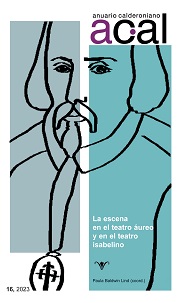Imágenes sincréticas en «Antony and Cleopatra» de Shakespeare y «Phèdre» de Racine
Resumen
Este artículo examina el espacio como disposición imaginaria en las tragedias Antony and Cleopatra de William Shakespeare y Phèdre de Jean Racine. Para ello se establece que el despliegue del espacio se logra a través de la caracterización de los personajes y de procedimientos y recursos retóricos. Los primeros aparecen como imágenes sincréticas de los mundos que encarnan o tableaux vivants y los segundos permiten la ampliación o circunscripción del espacio logrando una atmósfera y efecto.
This article examines space as an imaginary scenario in Shakespeare’s Antony and Cleopatra and Racine’s Phèdre. Related to this purpose, we established that the deployment of space is successfully achieved through the dramatic characters’ portrayal and rhetorical devices. The former appears as syncretic images of the worlds they embody or tableaux vivants, and the latter allow the enlargement or circumscription of the space achieving an atmosphere and dramatic effect.
PALABRAS CLAVE / KEYWORDS: Espacio; personaje; tableaux vivants; Shakespeare; Racine / Space; Character; tableaux vivants; Shakespeare; Racine.
Citas
Barthes, Roland, Sobre Racine, México, Siglo Veintiuno Editores, 1992.
Bevington, David, «“Above the Element they lived in”: the Visual Language in Antony and Cleopatra, acts 4 and 5», en Antony and Cleopatra. New Critical Essays, ed. Sara Munson, New York, Routledge, 2005, pp. 121-139.
Bold, Stephen, «The Anxiety of Senecan Influence in Racine, or Phèdre in the Labyrinth», Romanic Review, 92.4, 2001, pp. 417-432.
Bronfen, Elizabeth, «Cleopatra’s Venus», en Ancient Worlds in Film and Television: Gender and Politics, ed. A. Renger y J. Solomon, Leiden, Brill, 2003, pp. 137-150.
Bronfen, Elizabeth, «Hybrid Spaces in Antony and Cleopatra», en Shakespeare and Space. Theatrical Exploration of the Spatial Paradigm, London, Palgrave, 2016, pp. 103-120.
Hammond, Paul, «The Rhetoric of Space and Self in Racine’s Bérénice», Seventeenth Century French Studies, 36.2, 2014, pp. 141-156.
Hiscock, Andrew, The Uses of this World. Thinking Space in Shakespeare, Marlowe, Cary and Jonson, Cardiff, University of Wales Press, 2004.
John of Salisbury, Policraticus. The Statesman Books, ed. Murray F. Markland, New York, Frederick Ungar Publishing, 1979.
Kahn, Coppélia, «Skakespeare’s Classical Tragedies», en The Cambridge Companion to Shakespeare, ed. Claire McEachern, Cambridge, Cambridge University Press, 2002, pp. 204-223.
Karimi, M. A., «Tableaux Vivants: Their Structure, Themes, and Rhetorical Functions», Southern Speech Communication Journal, 42.2, 1977, pp. 99-113.
Kernodle, George, From Art to Theatre. Form and Convention in the Renaissance Chicago, Chicago University Press, 1944.
Lehmann, Hans-Thies, Tragedia y teatro dramático, México, Paso de Gato, 2017.
Mullaney, Steven, The Place of the Stage. License, Play and Power in Renaissance England, Ann Arbor, University of Michigan Press, 1995.
Orgel, Stephen, The Illusion of Power. Political Theater in the English Renaissan ce, California, California University Press, 1975.
Plett, Heinrich, Enargeia in Classical Antiquity and Early Modern Stage. The Aesthetics of Evidence, Boston, Brill, 2012.
Racine, Jean, Phèdre, en Œuvres Complètes, Paris, Éditions du Seuil, 1962.
Shakespeare, William, Antony and Cleopatra, ed. John Dover Wilson, Cambridge, Cambridge University Press, 2009.
Thorne, Alison, Vision and Rhetoric in Shakespeare. Looking through Language, London, Palgrave Macmillan, 2000.
Vogel, Julianne, Aus dem Grund. Auftrittsprotokolle zwischen Racine und Nietzsche, Padernborn, Wilhelm Fink Verlag, 2018.
West, William, «The Idea of a Theater: Humanist Ideology and the Imaginary Stage in Early Modern Europe», Renaissance Drama, 28, 1997, pp. 245-248.
Wilson, John Dover, «Introduction», en William Shakespeare, Antony and Cleopatra, ed. John Dover Wilson, Cambridge, Cambridge University Press, 2009, pp. vii-xxxvi.
Descargas
Publicado
Versiones
- 2024-08-27 (2)
- 2023-11-17 (1)
Cómo citar
Número
Sección
Licencia
Política propuesta para revistas que ofrecen acceso abierto diferido
Aquellos autores/as que tengan publicaciones con esta revista, aceptan los términos siguientes:
- Los autores/as conservarán sus derechos de autor y garantizarán a la revista el derecho de primera publicación de su obra [considerando un período de embargo editorial de 1 año], el cuál estará simultáneamente sujeto a la Licencia de reconocimiento de Creative Commons que permite a terceros compartir la obra siempre que se indique su autor y su primera publicación en esta revista.
- Los autores/as podrán adoptar otros acuerdos de licencia no exclusiva de distribución de la versión de la obra publicada (p. ej.: depositarla en un archivo telemático institucional o publicarla en un volumen monográfico) siempre que se indique la publicación inicial en esta revista y se considere el período de embargo.
- Se permite y recomienda a los autores/as difundir su obra a través de Internet (p. ej.: en archivos telemáticos institucionales o en su página web) antes y durante el proceso de envío, lo cual puede producir intercambios interesantes y aumentar las citas de la obra publicada.


